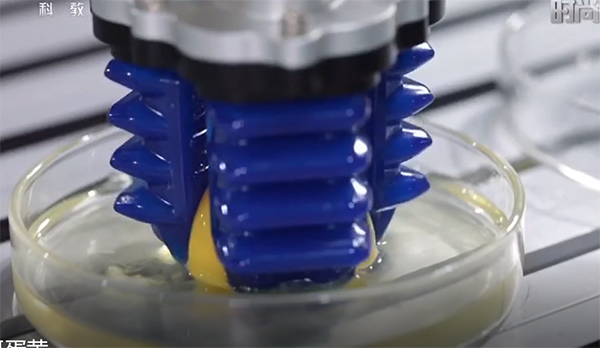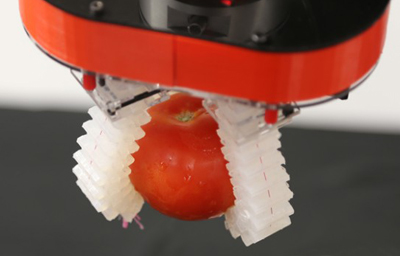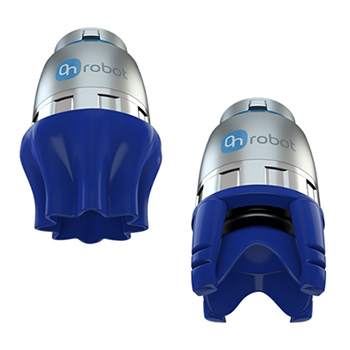
The Gripper Chronicles
Soft Grippers: Food Industry’s New Friend
Eliminating pathogens, people and wages from the $8.7T global food industry
Midway through George Whitesides’ lecture on soft robotics, he makes an interesting point about soft grippers that should grab the attention of every gripper developer.

Whitesides, a Harvard chemist, is world famous for the work he and his Whitesides Research Group have accomplished in pioneering soft robotics—specifically, soft gripper tech, for the better part of a decade. The soft gripper his team invented is out in the marketplace and doing well, which gives him the right to crow about it in his well-attended lectures.
He’s brilliant, a character, and low key but firm in his pronounce-ments about the future of soft robotics. He spun a DARPA grant from back in 2008 into a private company called Soft Robotics in 2013, perfected his soft grippers in 2015, sold many, and in January of 2020 closed on a $23 million investment from the likes of Yamaha, Honeywell, and FANUC…the world’s largest robot maker. That was on top of a cool $20 million investment from 2018.
His soft grippers went from a bare, untried idea in 2008 to $43 million worth of belief in 2020.
He’s a great success, so it’s easy to see why his entertaining lectures on soft robotics are closely followed and thoroughly reported on.
When, during his lectures, he says in an offhand way that food companies want to get rid of people in food production; saying that people are slow, and worse… they’re germ carriers, he’s hit upon a potential mother lode of robot gripper sales that, conceivably, could also spark mega-sales in cobots.
And since there are barely five makers of soft grippers selling their wares in the global marketplace today, Whitesides’ understated remark about food companies targeting people for an exit, is downright nuclear.
Here, in alpha order, are the youthful frontrunners of soft gripper tech:
OnRobot (Denmark, founded 2018)
Soft Robot Tech Co. (SRT) (China, founded 2016)
Soft Robotics (US, founded 2013)
The Gripper Company (Denmark, founded 2020)
UBIROS (US, founded 2019)
If you click over to the Cobotics World catalog of robots and grippers, there are over 100 grippers, 99 percent of which are hard or rigid grippers made from steel. Nearly all are off chasing after the holy grail of robotics—automated bin picking— where there’s untold billions of dollars awaiting a robot solution. Most soft gripper makers are also eyeing a bin-picking jackpot, although the food industry may well be their best chance for success.
Look around, there’s hardly a business larger than the food industry. Plunkett’s Research says the global food and agricultural industry totals about $8.7 trillion, or about 10 percent of the world’s GDP. That’s a mighty big playground in which to ply the sale of a soft gripper. There are millions of production workers in the food biz which, according to Whitesides, food companies would love to jettison. So, sales of soft grippers into food companies would be addressed to potential customers already predisposed to an alternative to human workers.
That’s a great entre, but there’s one better.
A singular motivation for switching out humans for robots with soft grippers is, as Whitesides says, humans carry germs.
Do we ever! Better than 70 percent of all foodborne illnesses are transmitted by people. “The pathogens most likely to be transmitted by food workers are norovirus, hepatitis A, Salmonella, Shigella, and Staphylococcus aureus.” That’s a bad group of human-hating viruses. And, as we’ve learned lately, COVID is a gang member as well.
“Pathogens of fecal, nose or throat, and skin origin are most likely to be transmitted by the hands, highlighting the need for effective hand hygiene and other barriers to pathogen contamination, such as no bare hand contact with ready-to-eat food.”
In the U.S., even with the passage in 2011 of “the FDA Food Safety Modernization Act, the U.S. is still experiencing hundreds of food recalls every year, many of which are extremely serious; 1 in 6 Americans contracts a foodborne illness every year. The most hazardous meat and poultry recalls (Class I) have nearly doubled since 2013 with an 85 percent increase. Class I refers to food that presents serious health risks such as containing botulinal toxins or undeclared allergens.”
See related:
Automated Meat Processing Post-COVID
Humans in the loop is a virus time bomb. New-age infrastructure change is needed to secure the meat supply Even if pathogens are not a worry, things like bruised fruit or crushed bakery and confectionary foods can be helped out by soft grippers. In the U.S., the State of Washington produces 5 billion apples annually. Each one is laboriously handpicked and then further human-handled from orchard to supermarket. Times five billion is a lot of labor! Robots with soft grippers could be a low-cost, tireless, and speedy alternative to human labor. Soft grippers are gentle on fruit, as well as many other food items, so they should be naturals for the food industry.
Even if pathogens are not a worry, things like bruised fruit or crushed bakery and confectionary foods can be helped out by soft grippers. In the U.S., the State of Washington produces 5 billion apples annually. Each one is laboriously handpicked and then further human-handled from orchard to supermarket. Times five billion is a lot of labor! Robots with soft grippers could be a low-cost, tireless, and speedy alternative to human labor. Soft grippers are gentle on fruit, as well as many other food items, so they should be naturals for the food industry.
On a secondary level, soft grippers could benefit the nation’s health. With the population of the U.S. at 331 million, what sort of relief would the healthcare system experience when 55 million (the 1 in 6 who annually contract a foodborne illness) don’t need treatment?
The soft gripper is a youthful technology; as noted from the list of five, the eldest developer opened shop in 2013; the most recent two, UBIROS and The Gripper Company, in 2019 and 2020 respectively. That’s young, although laboratory research in the concept has been around since 1980. See the chronological chart in Jun Shitake et al Soft Robotic Grippers, for a look back at the evolution of soft grippers using either actuation, or controlled stiffness, or controlled adhesion. Today, in addition to the five in the marketplace, there are another half dozen plodding along in labs.
The contenders
There is certainly room for all five soft gripper contenders in the food industry. All five are made from food-safe and stretchy elastometric materials, including elastic silicone; and all five have been approved for food handling both in the U.S. and the EU (FDA 21 CFR, and the EU’s EC 1935/2004 certifications), plus all are washable.

Two are nearly twins: Soft Robotics (U.S.) and SRT (China). Both “use networks of channels in elastomers that inflate like balloons for actuation. Using a series of parallel chambers embedded in the elastomers as a repeating component and then stacking or connecting these components enables us to design and test prototype structures providing complex movements by intuition (empirically),” says Soft Robotics.

Both use an external air supply for pneumatic actuation. Basically, an operator sets the pressure (unless there are presets) according to the work piece (food item) to be gripped and lifted, the channels stretch open to grasp, gently close or deform around the food item, and then lift the food item away.
The gripper from Soft Robotics was birthed in Whitesides’ Harvard laboratory; SRT (officially, Soft Robot Tech Co., LTD) was birthed at the Robotics Institute of Beihang University.
UBIROS, spawned from the Robotics Engineering Lab at Worcester Polytechnic Institute (WPI), looks and acts similarly, but is driven differently. The big differentiator with UBIROS actuation is that its soft grippers are fully electrically actuated and not pneumatic. It has no need for cleaning air hoses or an awkward air supply hose or tank, which makes it convenient to use on a mobile robot or to move with ease anywhere along a production line.

Onder Ondemir, president and CEO of UBIROS has an interesting business model to go along with his soft grippers. First off, you can get a 15-day free trail, if you just want to kick the tires to see how the gripper performs. Customers can either buy or lease (purchase price is $2400), or opt for a pay-per-pick arrangement at $300 down and $0.5 per pick.
New-look soft geometries
Two of the contenders, both Danish, OnRobot and The Gripper Company, have come up with some cool-looking new geometries for grabbing things.
The OnRobot soft gripper uses three, interchangeable cups in star and four-finger configurations (see photo). The flexible silicon-molded gripper is certified for food (FDA 21 CFR and EC 1935/2004), and like the UBIROS gripper, it too is all electric. Again, no need for an external air supply.

The newest kid on the soft gripper block is The Gripper Company (just emerged from stealth mode). Helmed by long-time robotics industry veteran Preben Hjørnet, The Gripper Company’s offering is a modular, pneumatic four-finger soft gripper (see photo and video). The fingers can be solid polyurethane or polyurethane fingers reinforced with a rod, enabling them to conform around most any workpiece.
Fine ripples on the fingertips enable a secure grip on hard, smooth surfaces, even when wet. “The lip can be fitted with control bands for additional compliance, or left hollow with room for larger workpieces.”

Hjørnet’s engineer’s hat was firmly on when he put the design criteria together. Amazingly, his design consists of four graded grippers and fingers allowing for configurations resulting in eight different builds. Presumably leaving no workpiece or object unpickable. In fact, he’s even added “fingernails” as attachments to the fingertips. Need to play Pick-up Sticks? Not to worry, Hjørnet’s fingernails got you covered.
With scads of cobot and robot models in the marketplace, The Gripper Company, like most others in the soft gripper group, offers an “Any Mount” that easily attaches to and is interoperable with robot and cobot arms from all the major vendors, including Omron Adept, ABB, and Rethink Robotics.
Such variety would seem to play well with the near-infinite variety of consumables in the food industry, and useful as well for either primary or secondary packaging processes.
Variety is also favorable in the way The Gripper Company sells: by online catalog only. Mixing and matching exact parts for any picking job is relatively easy. Also, Hjørnet says online-only sales, bypassing integrators or a direct sales force, is a big help with pricing. For example, The Gripper Company’s $812 four-finger gripper plus $800 Any Mount total out to $1612, which is about half the asking price of $3500 for OnRobot’s four-fingered gripper. If you’re an SME, that’s a big deal. Even a startup like UBIROS is asking $2400 for its soft gripper.
Of course, the ultimate reality of the soft gripper revolution for the food industry, regardless if they cost $1600 or $3500, is that they are a liberating resource. They eliminate boringly mindless jobs on a production line, which makes for a great case for fast ROI; they are eminently flexible given the variability of food products on processing lines; and they are safe, unlike workers, from being agents for any foodborne virus or bacteria.
All good reasons as to why George Whitesides might say in a lecture that the food industry is looking to exit its workers. Indeed, the time is ripe.
